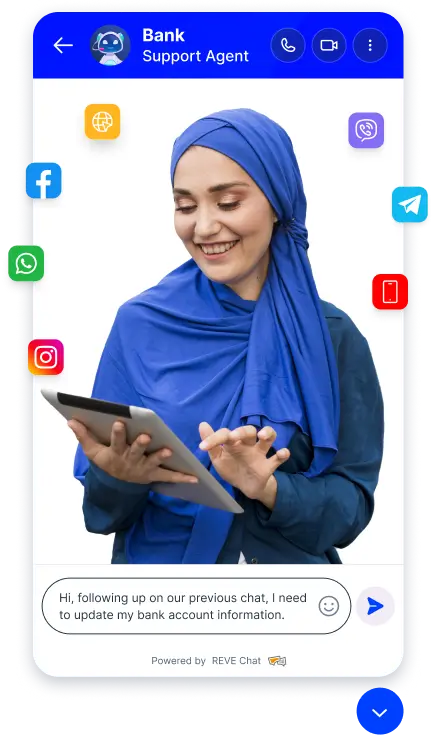Banks are looking to automate maximum of their repetitive tasks with better utilization of AI, especially in customer services. Now customers no longer need to wait in long queues to get their desired assistance. Also, the improved CX functionality reduces 50% level-1 support cost for banks.
In recent years, an emerging technology- Chatbot has significantly shaped how banks communicate, operate, and function with customers. The integration of chatbots has brought revolutionary upgrades to digital banking experiences.
Let’s guide you in detail on how chatbots have come forth to be the next game-changing feature in the banking industry.
A banking chatbot is an AI-enabled conversational interface to interact with customers and provide help. It uses artificial intelligence or simple if/then statements to recognize words or phrases and respond accordingly.
Chatbots for banking are incredibly powerful and can manage smart communications on behalf of the bank. With a banking bot, it’s possible to handle millions of users simultaneously and enhance their experience.
During the initial stages, financial institutions such as Bank of America initiated trials with basic functional chatbots primarily focused on customer support. As an illustration, Bank of America launched "Erica," a virtual financial assistant aimed at aiding customers with fundamental banking activities. These initial chatbots operated as rule-based systems, functioning based on predetermined scripts and decision trees.
As time has progressed, there has been a significant development from rule-based systems to AI-powered chatbots in banking. Around the mid-2010s, financial institutions like Wells Fargo and Capital One embraced technological innovations, integrating NLP and AI functionalities into their chatbot systems.
Around the years 2019 to 2020, notable banks including JPMorgan Chase and HSBC made significant financial commitments to AI-driven chatbot technologies. The progress has continued since then. At present, a large number of banks are heading towards digital banking, incorporating banking chatbots as their core functional system in customer engagement.
In addition to banks, globally renowned fintech pioneers have also begun harnessing the innovative capabilities of chatbots since then. bKash, a leading global provider of Mobile Financial Services (MFS), overhauled its customer app in September 2019, integrating cutting-edge technologies and customer-focused features to enhance user experience. As a part of the advancement, bKash introduced a chatbot as part of its customer service solution in 2022.
Customer service chatbots in the banking industry are focused on assisting customers with general inquiries, troubleshooting issues, and providing support. They can understand and respond to a wide range of customer queries related to account management, banking products, and services.
Transactional chatbots are designed to handle basic banking transactions and inquiries. They interact with users to perform tasks such as checking account balances, transferring funds between accounts, paying bills, and providing transaction history.
Personal finance chatbots offer tailored financial advice, insights, and recommendations based on users' financial data and preferences. They help users track their spending habits, set savings goals, create budgets, and manage investments.
Lead generation chatbots engage users and collect information to generate leads for banking products or services. They interact with users to gather data such as contact information, preferences, and financial needs, which can be used for targeted marketing and sales efforts.
Educational chatbots in banking provide users with information, resources, and guidance on various financial literacy topics. They offer tips, articles, tutorials, and interactive tools to help users improve their financial knowledge, skills, and behaviors.
Security chatbots focus on ensuring the security of banking transactions and accounts by proactively identifying and addressing security threats and providing guidance to users on security best practices. They monitor account activity, detect suspicious behavior, and alert users about potential security risks.

Customers should be able to access basic account information like balances, transaction history, and recent statements.
Features like blocking lost or stolen cards, reporting suspicious activity, and requesting new cards can significantly enhance user experience.
Chatbots can leverage AI to personalize interactions by remembering user preferences, offering relevant suggestions, and tailoring responses based on past interactions.
Implementing strong authentication methods like two-factor or multi-factor authentication is crucial to protect sensitive financial information.
All communication between the user and the chatbot, including login credentials and account details, should be encrypted using industry-standard protocols.
Integrating AI-powered fraud detection systems can help identify and prevent suspicious activity, safeguarding user accounts.
According to our survey of current banking clients, 87% prefer receiving immediate support from a chatbot rather than waiting in a queue for human support agents. Here is how a chatbot works in the banking system.
NLP is a branch of artificial intelligence that deals with the interaction between computers and humans through natural language. For chatbots, NLP enables them to understand and interpret human language, whether text or speech.
NLP breaks down the input text into smaller units such as words or phrases. Then, it analyzes the grammatical structure of sentences to extract meaning. It Identifies entities such as names, dates, and locations mentioned in the text and determines the sentiment or tone of the text. The language model then predicts the next word or phrase based on the context of the conversation. Finally, it generates responses that sound natural and coherent to the user.
Machine Learning is a subset of artificial intelligence that enables systems to learn and improve from experience without being explicitly programmed. Chatbots use ML algorithms to understand user input, learn from past interactions, and generate appropriate responses.
Now, in this model, chatbots are trained on large datasets of conversations to learn patterns and associations between user inputs. It identifies relevant features from the input text, such as keywords, entities, or context. The algorithm selects the appropriate ML algorithm based on the task.
Finally, The chatbot's ML model is trained on the labeled training data to optimize its performance. When a new input is received, the trained model predicts the most likely response based on the learned patterns.
Rule-based systems operate on predefined rules and logic programmed by developers. These rules govern how the chatbot interprets user inputs and generates responses.
The chatbot matches user input against predefined patterns or rules to determine the appropriate response. Once it finds a matching rule, the chatbot generates a response based on the corresponding rule.
The rule-based systems often include fallback mechanisms to handle inputs that don't match any predefined rules. For example, providing a default response or escalating the query to a human agent. The system requires regular updates and maintenance to adapt to changes in user behavior. Also, to add new rules as needed.
Hybrid approaches in chatbots work by combining any two strategies of the given above. For example, a hybrid chatbot can leverage the strengths of both rule-based and NLP chatbots. Rule-based systems will handle frequent, simple queries efficiently, while NLP tackles complex questions and learns from interactions.
High programmed chatbots work under two-tier systems. The first tier is the rule-based system, equipped with a decision tree or flow chart. It handles common questions, pre-programmed responses. If more complex queries come, it escalates the conversation to the second tier of more advanced programming.
Increase in incoming queries
Faster response time
Less chat abandoned rate
A banking chatbot significantly streamlines account management tasks. It offers users quick and convenient access to account-related information. Here we’ve some of the common use cases of our Banking Chatbot in account management.
Chatbot provides quick access to financial information without the need to log into an online banking account or visit a physical branch.
Collects necessary information, such as personal details and identification documents, and assists with completing the account opening procedure.
Users can request a summary of their recent transactions, typically covering the last few transactions made on their account. Chatbot then provides a quick overview.
Users can request a comprehensive account statement, usually covering a specific period, such as the previous month or quarter.
BVN is a unique identification number issued by banks to customers to prevent identity theft and fraud. Chatbot can assist in verifying BVN.
In case of a lost or stolen debit or credit card, users can use the chatbot to immediately block the card to prevent unauthorized transactions.
Perform various account maintenance tasks through the chatbot, such as updating contact information, changing account preferences, or linking additional accounts.
In situations where users suspect fraudulent activity or want to temporarily restrict access to their account, they can request the chatbot to freeze their account.
Update personal information, such as address, phone number, or email address, through the chatbot. Ensure that the bank has accurate and up-to-date information.
In banking, the chatbot guides users through the transaction process, prompting for necessary details and confirming the transaction before executing it. Let’s look at some use cases,
Users can specify the biller, enter the amount, and authorize the payment, and the chatbot handles the transaction securely and efficiently.
Initiate fund transfers between their accounts or to other accounts within the same bank or to different banks through the banking chatbot.
With a banking chatbot, users can check their account balances in real time by simply asking for the information.
The banking chatbot provides immediate assistance to customers round-the-clock, addressing their queries and concerns in real time. It improves customer satisfaction.
A banking chatbot serves as a virtual helpdesk, providing users with assistance and support for a wide range of banking-related inquiries and issues.
Users can submit details of their complaints, such as the nature of the issue, relevant account information, and any supporting documentation, and the chatbot will log the complaint and initiate the resolution process accordingly.
The chatbot can ask users to rate their satisfaction levels, provide comments or suggestions for improvement, and collect demographic information for analysis purposes.
Banking chatbots are accessible through various channels such as websites, mobile apps, or messaging platforms. Your customers can engage with chatbots instantly, without waiting in queues or navigating through automated phone systems.
When a customer interacts with the chatbot, it utilizes natural language processing (NLP) to understand the query. The chatbot then retrieves relevant information from the bank's databases to provide accurate responses.
Chatbots facilitate banking transactions directly within the chat interface. Customers can initiate transactions in real-time without needing to switch to a separate banking app or website. The chatbot guides customers through the transaction process, ensuring accuracy and security.
Banking chatbots leverage customer data and transaction history to offer personalized recommendations & assistance. by understanding the context of the conversation and previous interactions, chatbots can provide tailored solutions to customer queries.
Some banking chatbots offer educational resources and tips on financial literacy topics. Customers can receive guidance on budgeting, saving, investing, or understanding complex financial products.
While chatbots handle many customer queries independently, they also recognize when an issue requires human intervention. If a query is beyond the chatbot's capabilities or if the customer prefers to speak with a human agent.

No more
long wait times
Cut excess
operational costs
Streamline complex
support processes
Solve more problems in
a reduced duration

Encryption: Banks use secure encryption to protect sensitive information exchange through chatbots. It is thus, difficult for hackers to intercept and steal the data. Even if they manage to gain access to the communication channel, they are not able to enter the system.
Authentication: Chatbots usually require authentication before allowing access to sensitive information or performing transactions. This can involve multi-factor authentication, such as entering a password and a code sent to your phone, adding an extra layer of security.
Fraud detection: Some chatbots in banking use AI to analyze data and identify suspicious activity that might indicate potential fraud attempts. This can help to prevent unauthorized transactions and protect customer accounts.
Note: Chatbots in the banking industry offer a secure and convenient way to access banking services, but it's vital to remain vigilant and exercise caution when using them.
Addition of Safety Instruction for Users
Beware of any unusual requests: If the chatbot asks for information you wouldn't typically share with a bank representative, such as your full social security number or password, stop the conversation and contact the bank directly. Never share your login credentials through the chatbot: Always log in to your bank account directly through the official website or mobile app.
Review the bank's security policies: Understand how the bank protects your information and what steps they take to ensure the security of their chatbots.
In the future, more sophisticated AI and machine learning algorithms will enable chatbots to understand complex user queries, analyze financial data, and provide personalized financial advice and recommendations.
Chatbots will move beyond simply answering questions and evolve into proactive assistants, anticipating customer needs, suggesting personalized financial solutions, and offering timely reminders for important financial tasks.
Increased transparency about data collection and usage practices will foster user trust. Customers will likely have more control over the data they share with chatbots and how it is used.
Our Hybrid Banking Chatbot revolutionizes customer interaction within the banking sector by combining supervised learning via the NLP/NLU pipeline with unsupervised learning through LLM for a comprehensive understanding of various business knowledge sources.
The chatbot seamlessly integrates supervised learning via the NLP/NLU pipeline. This ensures a structured approach to understanding and responding to customer queries.
It incorporates unsupervised learning through LLM to extract insights from diverse sources such as PDFs, Docs, Text, XLS, and web URLs. This enables the chatbot to tap into a wide array of information for more comprehensive responses.
The chatbot operates optimally by prioritizing the NLP/NLU pipeline for efficient query resolution. This ensures that customer queries are addressed promptly and accurately.
The system focuses on delivering concise and precise responses by leveraging the structured approach of the NLP/NLU pipeline.
The chatbot resorts to LLM for unsupervised learning only when necessary. This selective usage ensures that the focus remains on accuracy and minimizes any deviation in responses.
The Hybrid Chatbot enables text-based conversational responses from LLM with interactive components like carousels and quick replies from our chatbot builder. This ensures richer communication.
The chatbot utilizes LLM to generate text-based responses. These responses are crafted to be conversational, natural-sounding, and contextually relevant to the user's queries.
In addition to textual responses, our Chatbot Builder incorporates interactive components such as carousels and quick replies. These elements enhance the user experience by providing visually engaging options and streamlined navigation within the conversation.
By combining text-based responses from LLM with interactive components, the REVE Hybrid Banking Chatbot enables richer communication with users. It goes beyond mere text to offer a more dynamic and engaging conversational experience.
The Chatbot Builder allows for customization and flexibility in designing the interactive components, enabling personalized interactions tailored to the specific needs and preferences of the banking customers.


Connects chatbot to other systems for a more customizable service.
Understands and responds naturally to user queries.
Determines the emotional tone behind a user's input to respond better.
Determines the emotional tone behind a user's input to respond better.
Able to translate queries and responses in real-time in 25+ languages.
Understands context, handles complex queries, & generates appropriate responses.

Give your visitors the best of both worlds, the flexibility of switching to live chat with human agents for complex scenarios.

Collaborate with your customers using co-browsing to swiftly resolve their issues, enhancing understanding and eliminating confusion.

In the future, chatbots will be able to handle a wider range of tasks, potentially including even complex financial transactions. They may use features like optical character recognition (OCR) to process documents. They will better analyze the data and provide tailored financial recommendations.
Around 65% of banks use AI at some point in their tasks. Among them 30-35% use chatbots to automate customer engagement. More number of banks globally are trying to implement chatbots in their systems.
Yes, the banking chatbot is available 24/7 to assist you with your banking needs, providing round-the-clock support and access to your account information.
REVE Banking Chatbot facilitates seamless human handover. If the chatbot is unable to understand your request or answer your question, it will often offer to connect you with a live customer service representative.
Yes, the banking chatbot uses secure communication protocols to protect your personal information. You should never be asked to provide your account login credentials directly within the chat.